Novak dribble-drive
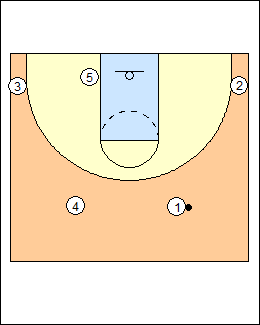 | 1 Doug Novak www.coachdougnovak.com Doug Novak's drive-and-space offence is based on dribble-drive motion. He also uses other actions such as Princeton point and chin series, which are not covered here. 1) Entries 4) Wing-wing 5) Swing 6) Snapback See YouTube video - Doug Novak Core Series, including - Fingers - Punch (post-up) - Fat - Fan - Forwards out - Escape - Snapback - Spaghetti - Buttonhook - Nail See Dribble-drive drills - Doug Novak Shooting. Michael Lynch uses a similar approach, annotations are included. See his Slot Blur Screens, YouTube playlist Blur Screen DDM. See Offence - Dribble-drive outline, Tactics - Dribble-drive quick-swing. |
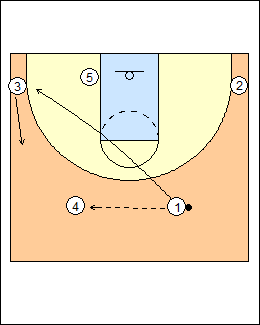 | 1) Entries See 4-4 Drive and space (pdf). a) Fingers 1 passes to 4 and corner cuts. The corner moves up to the wing on any guard-to-guard pass. Lynch - pass through a single gap to open the gap. On any slot to slot pass, the passer 45 cuts to the ballside corner. On a slot to wing pass (pass down), cut away to the weakside corner. Attack double and triple gaps. |
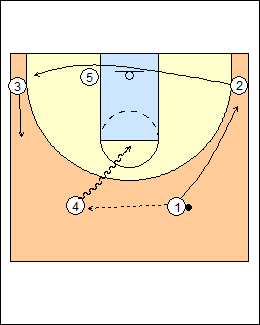 | b) Fan 1-4 pass, 1 spaces to the corner, pushing through 2. See Quick hitters - Dribble-drive 243-143 (optionally use a fan cut if 1 is a better shooter than 2). Mark Cascio - Families of Action for Conceptual Offence - a fan cut takes away a switch and keeps your best players in the action. Fingers, fan, or pass and follow into a ghost screen (which is better with pressure on the ball). Randy Sherman - Improve Conceptual Offence - a) drive opposite a catch (away from where you caught it, not back into the teeth of the defence), b) attack the larger space, |
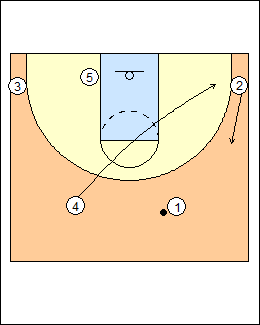 | c) Slice 4 corner cuts, opening up a triple gap for 1. 1 can pass to 2, see Swing and Snapback. Lynch - if 4 is denied 1 waves him thru, a blur screen (corner cut). A 1-2 DHO is another option. Optionally 4 fills the other slot then just cuts automatically. See Dribble-drive outline (Dive). |
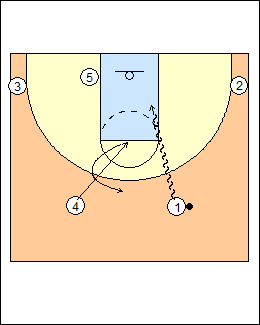 | 5 d) Buttonhook Cut to the nail, escape opposite a drive by 1. See Offences - Calipari dribble-drive, Kentucky dribble-drive. |
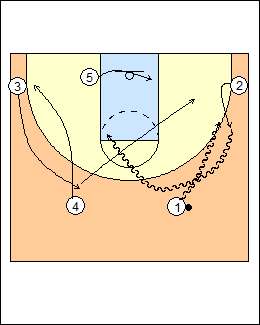 |
 | 2) Top-corner series See Quick pitch series, Escape shooting, Player development (pdfs). a) Quick pitch After 1-4 fingers, 4 drives and passes off the dribble to 2 (a quick pitch), dives and posts up. Lynch - 2 holds the corner until the last second, shoots on a kick-out pass or drives through the elbow area and 4 exits to the corner. 4 does not need to exit weakside on a corner kick-out. |
 | 8 4 exits (escapes) opposite if 2 drives baseline or middle (shown). 2 can pass back to 4 for a shot (escape shooting). See Doug Novak Core Series - Punch, a post entry on a throwback pass to 4. |
 | 9 Baseline drive. See Doug Novak Core Series - Forwards out. |
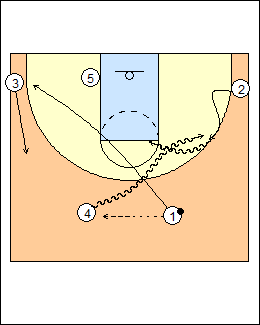 | 10 b) Veer dribble 4-2 DHO, 2 can attack middle or baseline. Other options - 2 shoots behind the dribble screen - 4 keeps the ball and attacks the rim (or gets into a Barkley dribble post-up) - 2 backcuts for a pass - 2 backcuts, clears if not open, 4 keeps the ball, and can get into a Barkley. |
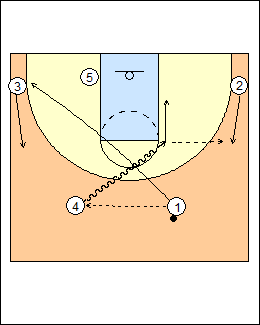 | 11 c) Stride stop A stride stop tells 2 that 4 needs help, get open with a fill cut (lift, kick up) or fat cut (backcut). 4 dives and posts on a pass to 2 filling, 2 can make a post feed to 4 or drive baseline or middle, 4 escapes opposite (look for a drift pass to 1 on a baseline drive). Lynch - 2 backcuts or kicks up after the ball is stopped. In conventional dribble-drive, 4 would replace 2 in the corner. See Doug Novak Core Series - Fat, Escape.  |
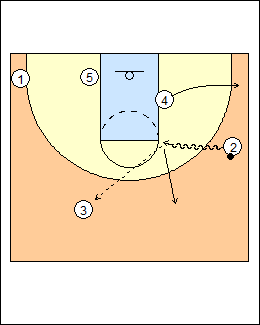 | 3) Wing-top series a) Quick pitch 2 drives middle, 4 escapes opposite, at or before the elbow 2 makes a quick pitch to 3 (who has rotated from the corner). If 2 has no momentum, he can check (pop out) to the other slot. Conventional dribble-drive assumes that 2 will get at least far enough for a kickback with 3. |
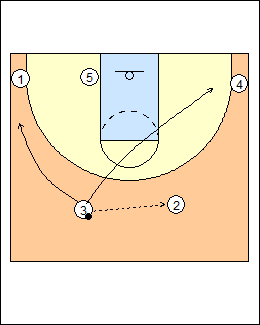 | 13 3 can make a boomerang pass to 2 and create space with a fingers or fan cut. |
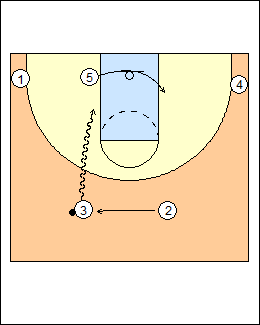 | 14 Here 3 drives the slot, 2 fills behind. |
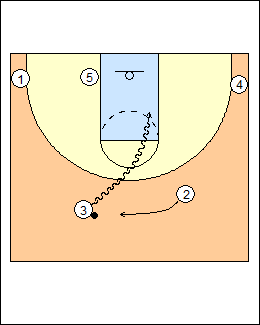 | 15 3 drives middle, 2 rotates behind looking for a pitchback. |
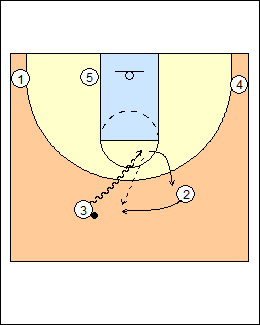 | 16 Here 2 gets a pitchback. |
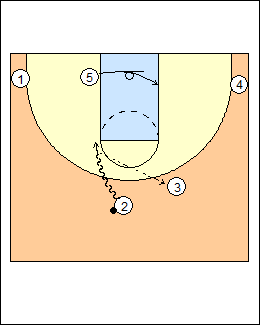 | 17 2 can attack, stride stop, spin back and pass to 3. |
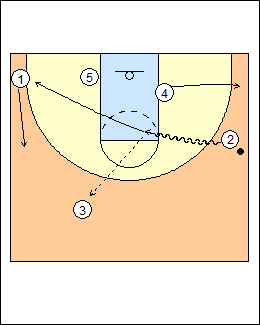 | b) Pitch fingers 2 gets deeper or has more momentum on the drive, pitches to 3 and continues to the corner (fingers cut). If you throw it on the run, stay on the run. 3 can attack right. Lynch - 2 makes a "change" pass to 3 then makes a blur screen cut to the corner (always). John Leonzo - Dribble-drive - if 2 kicks to 3 we are right back to the start of the offence (pass and corner cut); if 2 kicks to 1 in the corner, he exits slowly to fill the corner, 1 must shoot or swing it up. |
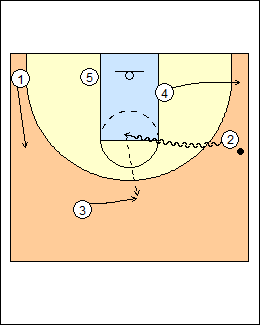 | 19 c) Pitchback 2 drives middle, hits 3 on a pitchback, then has buttonhook options (escape opposite a drive). |
 | 20 |
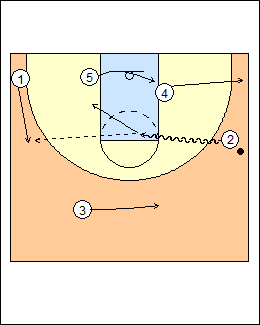 | 4) Wing-wing By-pass the top, 2 drives middle, passes to 1 lifting to the wing, posts up |
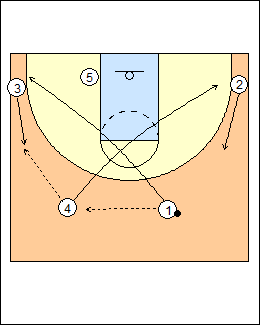 | 5) Swing See Swing advantage series (pdf). 1-4 fingers, 4-3 pass and clear weakside (a 1-4 pitchback or fake pitchback is another option). Variation - 4 spaces to the top of the key on the pass to 3 ("short fans"), can get a boomerang return pass. See Snapback. 3 can pass to 1 in the corner, see below, also Mark Cascio Favourite Possessions at 2:06. Lynch - on a "reverse", 4 passes to 3 as soon as he catches it. |
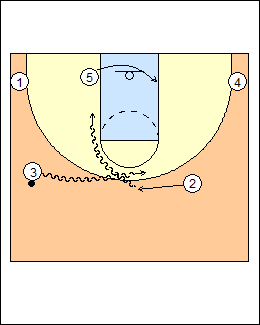 | 23 Spaghetti Swing into a 3-2 DHO. See Cascio Dribble-drive pitchbacks, Tactics - Dribble-drive quick-swing. |
 | 6) Snapback See Snapback advantage series (pdf). 1-4 fingers, 4 drives middle, passes back to 3 on the wing, spaces to replace 1. Variation - Snapback Fan - 1 passes to 4 and fan cuts. Lynch - if 4's drive fails in the first couple of dribbles, he snaps it back to 3 slow filling out of the corner, then cuts to the weakside corner. You have to snap if they switch. |
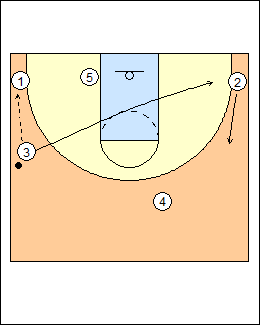 | 25 See Wing-top and Wing-wing series for options with 4 and 2. 3 can pass to the corner and clear. Lynch - to open gap space, pass it down to the original passer, cut away. |
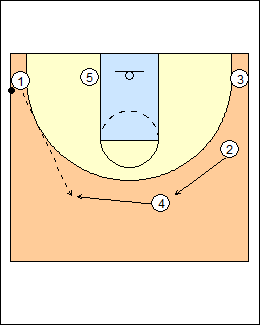 | 26 |
This page was made with Basketball playbook from Jes-Soft